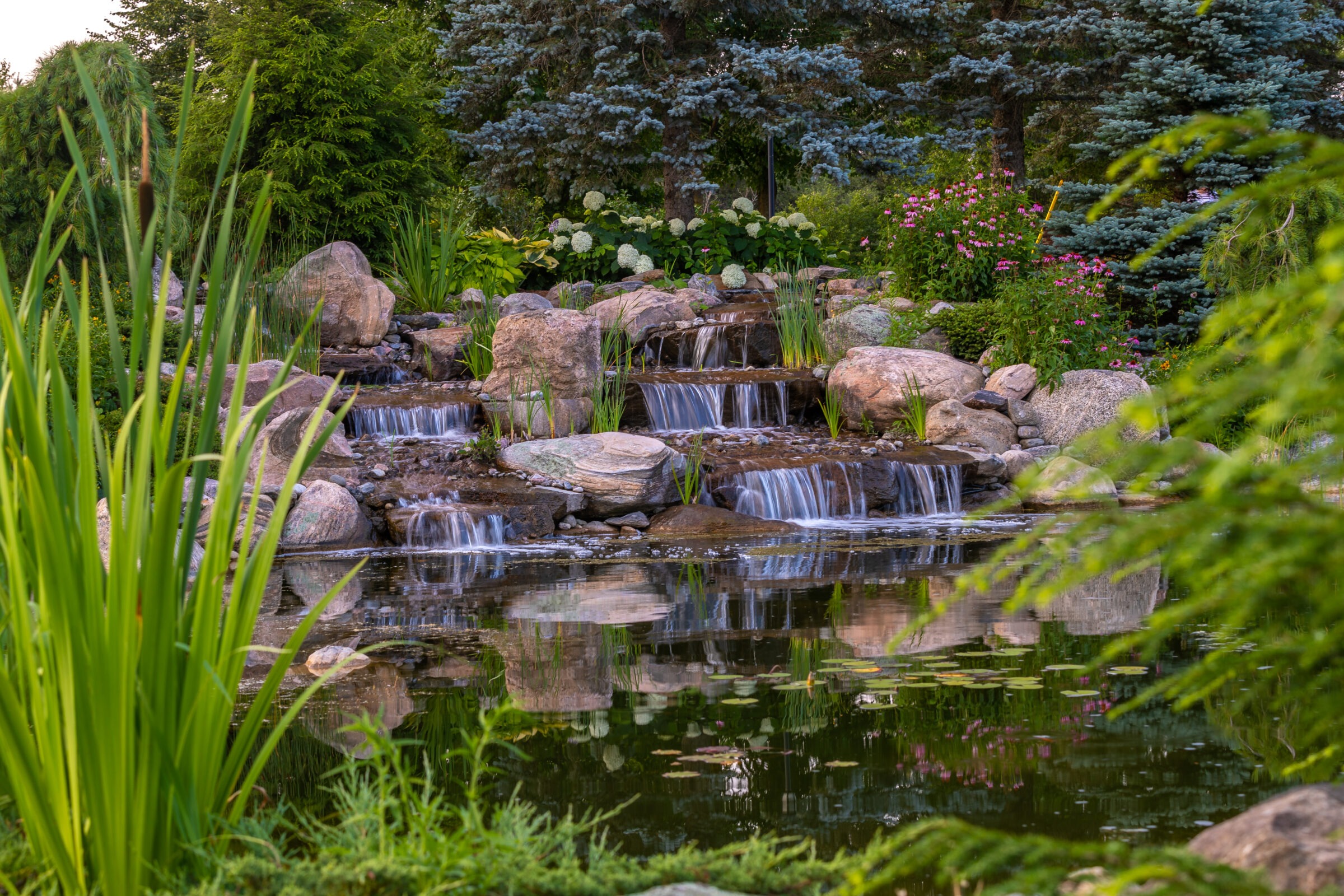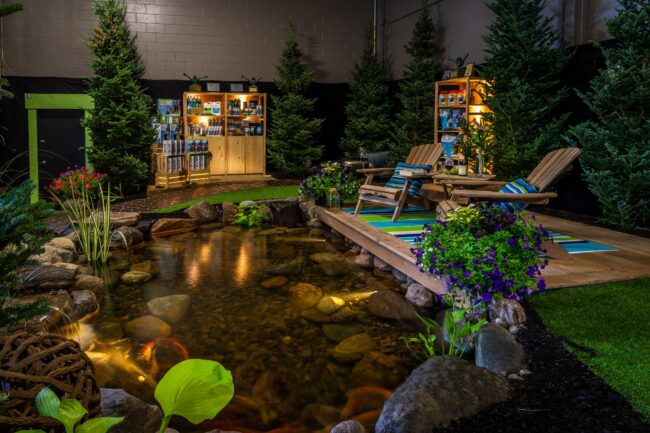Pond vs. Pondless Waterfalls: Which Is Right for Your Yard?

When considering the “pond vs. pondless waterfalls” debate, many homeowners face a tough decision. Both options can enhance your outdoor space, but they offer distinct experiences. A traditional pond brings tranquility and the joy of fish, while a pondless waterfall provides a stunning visual display without the maintenance of standing water.
As you navigate through this choice, it’s essential to weigh the benefits and drawbacks of each feature. On one hand, a pond can create a serene environment, attracting various wildlife. On the other hand, a pondless waterfall offers the beauty of cascading water without the concern of algae and debris.
In this article, we’ll delve into the differences between these two water features. You’ll gain valuable insights that will guide you in determining the best fit for your yard. Prepare to discover the perfect balance of charm, simplicity, and maintenance.
What’s the Difference?
When exploring your pond vs. pondless waterfalls options, it’s essential to understand the fundamental differences between these two features. A pond is a complete ecosystem, containing a substantial volume of water. It can support a variety of aquatic life, including fish, plants, and even frogs. This setup creates a serene environment, perfect for those who enjoy the presence of wildlife and the beauty of nature. However, maintaining a pond requires regular attention to keep the water clean and balanced, which can sometimes be a challenge.
In contrast, a pondless waterfall is designed to offer the beauty of flowing water without a visible body of standing water. Instead of a pond, the water cascades into a hidden reservoir below the surface. This system recirculates the water, allowing for a lovely waterfall effect without the need for constant upkeep associated with a traditional pond. Because there is no open water, pondless features are generally lower-maintenance, making them an attractive option for busy homeowners who still want the soothing sounds of water in their landscape.
When deciding on a pond vs. waterfall feature, it’s crucial to consider how each option aligns with your lifestyle and preferences. If you are someone who enjoys fish and plants and is prepared to maintain a vibrant aquatic ecosystem, a pond might be your ideal choice. However, if you prefer simplicity and ease without sacrificing aesthetics, a pondless waterfall could be the perfect fit for your yard.
Pond vs. Pondless Waterfalls: Pro vs. Con

Pros and Cons of Ponds
When considering pond vs. pondless waterfalls, it’s important to weigh the benefits and drawbacks. First, we’ll explore a clear breakdown of the pros and cons of ponds:
Benefits:
- Visual Impact: A pond can serve as a stunning focal point in your garden, enhancing the overall aesthetic of your landscape.
- Ability to Keep Koi Fish and Aquatic Plants: Ponds provide a habitat for colourful koi fish and various aquatic plants, enriching the beauty of your outdoor space.
- Creating a Mini-Ecosystem: With a pond, you foster a mini-ecosystem that supports local wildlife, such as frogs and beneficial insects, adding diversity to your garden.
- Tranquil Still Water: The presence of still water can create a serene atmosphere, making your yard a peaceful retreat for relaxation and enjoyment.
Drawbacks:
- More Maintenance: Regular upkeep is necessary to maintain water quality, which involves monitoring for fish health, managing algae growth, and cleaning debris.
- Higher Cost: The initial installation of a pond can be more expensive, considering excavation, lining, and other landscaping requirements.
- Need for Space: Ponds typically require more space than pondless features, which can be a limiting factor for smaller yards.
- Safety Measures for Depth: If your pond has deeper areas, you may need to implement safety measures, especially if children or pets are around.
Understanding the pros and cons of ponds can help you make an informed choice when comparing options. Both choices have unique characteristics, and knowing the pondless waterfall pros and cons can lead you to the perfect fit for your outdoor landscape.
Pros and Cons of Pondless Waterfalls
Pondless waterfalls offer a unique alternative to traditional ponds, making them an appealing choice for many homeowners. Here’s a detailed look at the benefits and limitations of pondless waterfalls:
Benefits:
- Easy Maintenance: Without the need for fish or stagnant water, pondless waterfalls require less upkeep, allowing you to enjoy the beauty of flowing water without the hassle.
- Safer for Kids: Since there is no deep water, pondless waterfalls present a safer option for families with young children or pets, reducing the risk of accidents.
- Fits in Small Spaces: The compact design of pondless waterfalls makes them ideal for smaller yards or gardens where space is limited, enabling you to create a stunning water feature without extensive landscaping.
- Typically Lower Installation Cost: In general, installing a pondless waterfall is less costly than creating a traditional pond, as it involves fewer materials and construction requirements.
Limitations:
- No Fish or Aquatic Plant Habitat: While pondless waterfalls provide the aesthetic of flowing water, they do not support fish or aquatic plants, which may be a drawback for those who enjoy a lively ecosystem.
- Requires Power and Pump: A pondless waterfall needs an underground pump to circulate the water, which requires access to power.
The term “pondless” signifies the absence of standing water, allowing the feature to be turned off when not in use, further minimizing upkeep. Understanding the pondless waterfall pros and cons can help you determine the best fit for your yard.
Pond vs. Pondless Waterfalls: Key Logistics

Cost & Maintenance Comparison
When considering the financial and upkeep aspects of your water feature, it’s important to understand the differences in costs and maintenance between a pond and a pondless waterfall. Building a pond tends to be more expensive upfront, not only due to the initial installation costs—like excavation, lining, and setting up a filtration system—but also because of the ongoing maintenance required. Ponds may need regular monthly care, including filter cleaning, water tests to ensure the right chemical balance, and managing algae growth.
On the other hand, pondless waterfalls usually offer a lower installation cost and minimal ongoing maintenance. With these features, the focus is on the flowing water, which requires less attention. While pondless systems still need occasional topping up of water due to evaporation and annual check-ups to ensure the pump is functioning properly, the upkeep is generally straightforward and less time-consuming.
If you love fish and don’t mind a bit of routine care, a pond can be a rewarding addition to your outdoor space. They provide a vibrant ecosystem with varied plant and animal life. However, if you prefer a hassle-free, fountain-like focal point that enhances your landscape without the need for constant attention, a pondless waterfall might be your ideal match.
In the end, your choice will depend on your lifestyle preferences and how much time and effort you’re willing to invest in your outdoor oasis. Understanding the ins and outs of a pond vs. pondless waterfalls and evaluating both the cost and maintenance needs will help you make an informed decision about the best water feature for your yard.
Making Your Decision
First and foremost, take a good look at your available space. If you have a small yard, a pondless waterfall might be the perfect fit for you. These features are often compact and can be designed to fit snugly into limited areas, allowing you to enjoy a beautiful water feature without overwhelming your landscape.
Next, think about your lifestyle and how you envision interacting with your water feature. If you’re someone who enjoys the idea of caring for fish, tending to aquatic plants, and observing the mini-ecosystem that a pond can offer, then investing in a pond may be the way to go. On the other hand, if you prefer to simply enjoy the sights and sounds of flowing water without the commitment of maintenance, a pondless waterfall might be the ideal option for your outdoor environment.
Lastly, consider how much time you can realistically dedicate to maintenance. Ponds often require regular upkeep and attention to ensure a healthy habitat for fish and plants. If you lead a busy lifestyle and don’t want to spend a lot of time on maintenance, a pondless waterfall presents a lower-maintenance solution that still offers the soothing sounds and aesthetic appeal of water features.
Backyard Water Features in Burlington
When it comes to enhancing your outdoor space in Burlington, choosing between pond vs. pondless waterfalls can significantly transform your backyard into a serene oasis. The rich, natural landscape of Burlington makes it an ideal setting for either water feature, allowing homeowners to create a stunning focal point while enjoying the soothing sounds of flowing water.
Whether you prefer the vibrant ecosystem of a pond with its lively fish and aquatic plants, or the ease and elegance of a pondless waterfall that fits seamlessly into any space, the options are plentiful. With careful consideration of your yard’s size, your lifestyle, and how much time you’re willing to dedicate to maintenance, you can find the perfect feature that complements your home.
Contact us to explore what kind of water feature will help you transform your outdoor space.
Tags:
